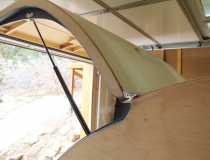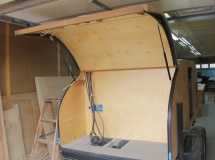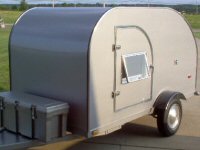WARNING--THIS POST CONTAINS MATH AND MECHANICAL ENGINEERING PERFORMED BY A FRUSTRATED (RETIRED) ELECTRICAL ENGINEER

So, I installed gas struts in our teardrop yesterday, which work okay, except somehow I mis-calculated the force required for each strut. I believe I've figured out the problem, and that is the subject of this long and technical post. Comments welcome!
First, here is the installation


Notice this is "reversed from normal" meaning the attachment points for the struts on the galley walls are closer to the hinge than the attachment points on the hatch. For this, and a few other reasons, I reverse engineered and then modified Dan Lott's calculator. (Apologies Dan!) (Errors, both the one mentioned below, and any so far undetected are, of course, mine.) Notice that with my installation, the struts, when the hatch is fully open, are not nearly vertical, and I think this is the key to the problem.
So, after determining the extended length (about 29.5 inches), the compressed length, and stroke (the difference between the two), the next step is to compute the force applied by the struts. Dan's method is to weigh the hatch near the middle and his spread sheet computes the weight at the attachment points using the ratio of the distances from the hinge. For me, it was more convenient to weigh the hatch at a point 41 inches from the hinge (42 lbs), and use the ratio (41 inches/29.75 inches) where 29.75 inches is the distance from my attachment points to the hinge. I believe that's okay.
That method yields a weight on the struts of 57.9 lbs, or about 29 lbs per strut. Dan's calculator includes a 10% safety factor, for 32 lbs/strut. Okay, I found some struts at McMaster-Carr with the correct extended length, compressed length, and 50 lbs force, so I should be good! (Incidentally, this seems to be much less than the force required on struts attached in the normal manner--Tony needs 90 lbs per strut for his new teardrop, for example. My engineering sense should have detected a red flag here--seems too good to be true that hanging struts backwards improves things that much; and in fact it is too good to be true!)
So, I ordered the 50 lb struts, and find they barely hold the hatch up! In fact, there are a few light weight objects I hadn't added yet--tail lights, dome light, the third brake light, and the hatch panel to access the lights, and when I set those on the hatch, it falls closed. So, what did I do wrong?
Well, one advantage of having the struts installed now is that I can measure (roughly) some angles, and a sketch of the system looks like this

Dimensions are as marked in black. I've included the weight at each attachment point with a blue arrow, labeled algebraically as "a lbs". (I'll try several a's, below.) Now, it's been almost 40 years since I've had the one course in mechanical engineering that I've ever had, but I think the weight (force due to gravity) has to be countered by forces extending from the struts, and from the hinge, as shown by blue arrows in the sketch. Since this is a statics problem (nothing moves, if I finally do it right) the magnitude of each force can be solved by making a triangle out of the force arrows

What I want is the force needed by each strut, which I've labeled "b lbs". This can be solved using something called the sine rule, and works to b = a*sin(111 degrees)/sin(30 degrees), or
b = a*1.87
There is a factor of almost 2 that I missed! Again, this (mostly) goes away if the struts wind up nearly vertical as with a normal installation.
To check this, let's go back to my original calculation. There a was 29 lbs (without the safety factor). b should then be 54.2 lbs. They should already fail! That they don't is probably due to some minor measurement errors--estimates on my part.
So, what do I really want? I measured 42 lbs at 41 inches from the hinge. The stuff I left out weighs about 5 lbs and will be spread somewhere between 48 inches and 20 inches from the hinge. Let's say for a round number 50 lbs at 41 inches, or 68.3 lbs at the strut attachment points. Divide that by 2 but multiply by 1.1 for the safety factor, and I find a = 37.6 lbs. That makes b = 70.3 lbs.
Unfortunately, the McMaster-Carr struts only come in 50, 100, .. lb increments, but I did find a pair on Amazon that are close in extended length and stroke, and have a force of 71 (not 70!) lbs. We'll see how good my engineering is....

Tom



